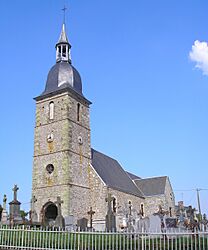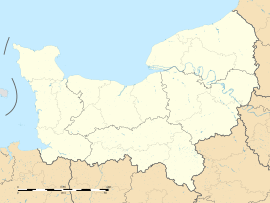Lassy, Calvados facts for kids
Quick facts for kids
Lassy
|
|
|---|---|
|
Part of Terres de Druance
|
|
 |
|
| Country | France |
| Region | Normandy |
| Department | Calvados |
| Arrondissement | Vire |
| Canton | Condé-en-Normandie |
| Commune | Terres de Druance |
| Area
1
|
12.6 km2 (4.9 sq mi) |
| Population
(2019)
|
315 |
| • Density | 25.00/km2 (64.7/sq mi) |
| Time zone | UTC+01:00 (CET) |
| • Summer (DST) | UTC+02:00 (CEST) |
| Postal code |
14770
|
| Elevation | 145–268 m (476–879 ft) (avg. 200 m or 660 ft) |
| 1 French Land Register data, which excludes lakes, ponds, glaciers > 1 km2 (0.386 sq mi or 247 acres) and river estuaries. | |
Lassy was once a small commune (which is like a local town or village area) located in the Calvados department. This department is part of the Normandy region in northwestern France.
Lassy is no longer a separate commune. On January 1, 2017, it joined with other nearby areas to form a new, larger commune called Terres de Druance.
Contents
About Lassy
Lassy was a small place with a rich history, typical of many villages in the French countryside. It covered an area of about 12.6 square kilometers (around 4.8 square miles).
Where was Lassy located?
Lassy was situated in the Normandy region of France. This area is known for its beautiful green landscapes and rolling hills. The former commune is also part of a special region called Suisse Normande.
What is Suisse Normande?
Suisse Normande translates to "Norman Switzerland." It's a scenic area in Normandy that gets its name because its landscape reminds people of the mountains in Switzerland. Even though it doesn't have huge mountains, it features deep valleys, rocky cliffs, and winding rivers like the Orne. It's a popular spot for outdoor activities such as hiking, kayaking, and rock climbing.
Lassy's Population Over Time
In 2019, just before it merged, Lassy had a population of 315 people. Like many small rural areas, its population changed over the years. For example, in 1962, there were 474 people living there, but by 1990, the number had dropped to 289. However, the population started to grow again in the early 2000s.
See also
 In Spanish: Lassy (Calvados) para niños
In Spanish: Lassy (Calvados) para niños



